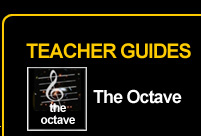






National Education Standards (9-12)
The following essay questions and worksheet correlate to:
MUSIC - CONTENT STANDARD 8
Understanding Relationships Between Music, the Other Arts, and Disciplines Outside the Arts
Students should explain ways in which the principles and subject matter of various disciplines outside the arts are interrelated with those of music
Note: These essay questions and worksheet are developed to satisfy general instructional objectives rather than strict standards matches.
ESSAY QUESTIONS
1. What is an octave?
2. What is the cycle of fifths?
3. How does the octave connect to the Cosmos?
WORKSHEET
The Musical Universe (pdf coming soon)
For further information about National Education Standards and lesson plans go to Education World.com
 Education World, the Educator's Complete Resource Guide to the Internet, offers education professionals, parents, students, and administrators a place where they can start each day to find the lesson plans and research materials they are looking for. This site is updated daily with fresh new lesson plans and curriculum ideas, articles on issues that are of interest to educators, parents, and students, and much more
Education World, the Educator's Complete Resource Guide to the Internet, offers education professionals, parents, students, and administrators a place where they can start each day to find the lesson plans and research materials they are looking for. This site is updated daily with fresh new lesson plans and curriculum ideas, articles on issues that are of interest to educators, parents, and students, and much more
THE OCTAVE - STUDENT STUDY GUIDE
In music, an octave (sometimes abbreviated 8ve or 8va) is the interval between one musical note and another with half or double the frequency. For example, if one note has a frequency of 400 Hz, the note an octave above it is at 800 Hz, and the note an octave below is at 200 Hz. The ratio of frequencies of two notes an octave apart is therefore 2:1. Further octaves of a note occur at 2n times the frequency of that note (where n is an integer), such as 2, 4, 8, 16, etc. and the reciprocal of that series. For example, 50 Hz and 400 Hz are one and two octaves away from 100 Hz because they are 1 / 2 (1 / 21) and 4 (22) times the frequency, respectively, however 300 Hz is not a whole number octave above 100 Hz, despite being a harmonic of 100 Hz.
The octave is the second simplest interval in music (after the unison). The human ear tends to hear both notes as being essentially "the same". For this reason, notes an octave apart are given the same note name in the Western system of music notation—the name of a note an octave above A is also A. This is called octave equivalency, and is closely related to the concept of harmonics. This is similar to enharmonic equivalency, and less so transpositional equivalency and, less still, inversional equivalency, the latter two of which are generally used only in musical set theory or atonal theory. Thus all C#s, or all 1s (if C=0), in any octave are part of the same pitch class. Octave equivalency is a part of most musics, but is far from universal in "primitive" and early music (e.g., Nettl, 1956; Sachs & Kunst, 1962).
As well as being used to describe the relationship between two notes, the word is also used when speaking of a range of notes that fall between a pair an octave apart. In the diatonic scale, this is 8 notes if one counts both ends, hence the name "octave", from Italian for 8. In the chromatic scale, this is 13 notes counting both ends, although traditionally, one speaks of 12 notes of the chromatic scale, not counting both ends. Other scales may have a different number of notes covering the range of an octave, but the word "octave" is still used.
In terms of playing an instrument, octave may also means a special effect, involving play two notes that are an ioctave apart at the same time. This effect may have to be conduct purposely. However, some instruments are purposely tuned/created to produce such effect, such as twelve-string guitar, octave harmonica, and etc.
In most Western music, the octave is divided into 12 semitones (see musical tuning). These semitones are usually equally spaced out in a method known as equal temperament.
The notation 8va is sometimes seen in sheet music, meaning "play this an octave higher than written." 8va stands for ottava, the Italian word for octave. Sometimes 8va will also be used to indicate a passage is to be played an octave lower, although the similar notation 8vb (ottava bassa) is more common. Similarly, 15ma (quindicesima) means "play two octaves higher than written." Coll'ottava means to play the passage in octaves. Any of these directions can be cancelled with the word loco, but often a dashed line or bracket indicates the extent of the music affected.
Circle of Fifths
In music theory, the circle of fifths is an example of a modulatory space. It consists of all 12 notes of the (equally tempered) chromatic scale. Starting on any note and repeatedly ascending by the musical interval of a perfect fifth, one will eventually land on the same note, after reaching all of the other notes.
Descending by fifths, and ascending or descending by fourths also works, since motion in one direction by a fourth is equivalent to motion in the opposite direction by a fifth. For this reason the circle of fifths is also known as the circle of fourths.
History
This was supposedly invented in the sixth century B.C. by Pythagoras. It is said that Pythagoras also had the idea of tuning an instrument by fifths and thus discovered the Pythagorean comma.
Pythagorean Comma
In music, when one ascends by a cycle of justly tuned perfect fifths (ratio 3:2), leapfrogging 12 times, one eventually reaches a note around seven octaves above the note one started on, which, when lowered to the same octave as the starting point, is 23.46 cents higher than the initial note. This interval, 531441:524288 or approximately 1.0136:1, is called a Pythagorean comma, named after the ancient mathematician and philosopher Pythagoras. It is sometimes called a ditonic comma.
This interval has serious implications for the various tuning schemes of the chromatic scale, because in western music, 12 perfect fifths and seven octaves are treated as the same interval. Equal temperament, today the most common tuning system used in the West, gets around this problem by flattening each fifth by a twelfth of a Pythagorean comma (2 cents), thus giving perfect octaves.
This article is licensed under the GNU Free Documentation License. It uses material from the Wikipedia article "Octave", Wikipedia article "Circle of Fifths"and Wikipedia article "Pythagorean Comma"




